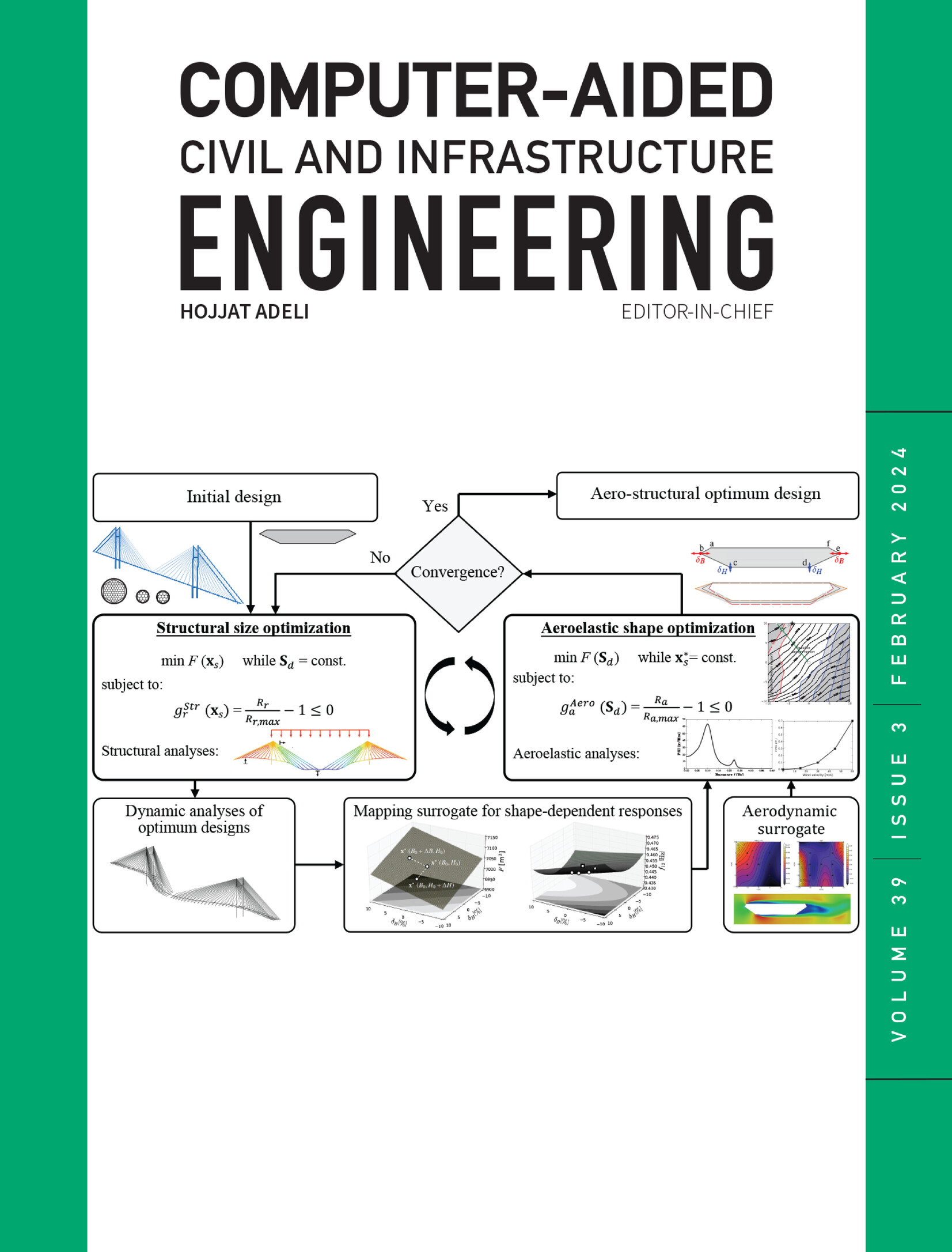Aeroelastic force prediction via temporal fusion transformers
IF 8.5
1区 工程技术
Q1 COMPUTER SCIENCE, INTERDISCIPLINARY APPLICATIONS
引用次数: 0
Abstract
Aero‐structural shape design and optimization of bridge decks rely on accurately estimating their self‐excited aeroelastic forces within the design domain. The inherent nonlinear features of bluff body aerodynamics and the high cost of wind tunnel tests and computational fluid dynamics (CFD) simulations make their emulation as a function of deck shape and reduced velocity challenging. State‐of‐the‐art methods address deck shape tailoring by interpolating discrete values of integrated flutter derivatives (FDs) in the frequency domain. Nevertheless, more sophisticated strategies can improve surrogate accuracy and potentially reduce the required number of samples. We propose a time domain emulation strategy harnessing temporal fusion transformers (TFTs) to predict the self‐excited forces time series before their integration into FDs. Emulating aeroelastic forces in the time domain permits the inclusion of time‐series amplitudes, frequencies, phases, and other properties in the training process, enabling a more solid learning strategy that is independent of the self‐excited forces modeling order and the inherent loss of information during the identification of FDs. TFTs' long‐ and short‐term context awareness, combined with their interpretability and enhanced ability to deal with static and time‐dependent covariates, make them an ideal choice for predicting unseen aeroelastic forces time series. The proposed TFT‐based metamodel offers a powerful technique for drastically improving the accuracy and versatility of wind‐resistant design optimization frameworks.基于时间融合变压器的气动弹性力预测
桥面气动结构的形状设计和优化依赖于其在设计范围内的自激气动弹性力的准确估计。钝体空气动力学固有的非线性特性以及风洞试验和计算流体动力学(CFD)仿真的高成本使得其作为甲板形状和降速函数的仿真具有挑战性。最先进的方法是通过在频域内插值积分颤振导数(FDs)的离散值来解决甲板形状裁剪问题。然而,更复杂的策略可以提高代理的准确性,并可能减少所需的样本数量。我们提出了一种时域仿真策略,利用时间融合变压器(TFTs)来预测自激力时间序列,然后将其集成到fd中。在时域中模拟气动弹性力允许在训练过程中包含时间序列幅度、频率、相位和其他属性,从而实现更可靠的学习策略,该策略独立于自激力建模顺序和fd识别过程中固有的信息损失。tft的长期和短期上下文感知能力,加上其可解释性和处理静态和时间相关协变量的增强能力,使其成为预测看不见的气动弹性力时间序列的理想选择。提出的基于TFT的元模型为大幅度提高抗风设计优化框架的准确性和多功能性提供了一种强大的技术。
本文章由计算机程序翻译,如有差异,请以英文原文为准。
求助全文
约1分钟内获得全文
求助全文
来源期刊
CiteScore
17.60
自引率
19.80%
发文量
146
审稿时长
1 months
期刊介绍:
Computer-Aided Civil and Infrastructure Engineering stands as a scholarly, peer-reviewed archival journal, serving as a vital link between advancements in computer technology and civil and infrastructure engineering. The journal serves as a distinctive platform for the publication of original articles, spotlighting novel computational techniques and inventive applications of computers. Specifically, it concentrates on recent progress in computer and information technologies, fostering the development and application of emerging computing paradigms.
Encompassing a broad scope, the journal addresses bridge, construction, environmental, highway, geotechnical, structural, transportation, and water resources engineering. It extends its reach to the management of infrastructure systems, covering domains such as highways, bridges, pavements, airports, and utilities. The journal delves into areas like artificial intelligence, cognitive modeling, concurrent engineering, database management, distributed computing, evolutionary computing, fuzzy logic, genetic algorithms, geometric modeling, internet-based technologies, knowledge discovery and engineering, machine learning, mobile computing, multimedia technologies, networking, neural network computing, optimization and search, parallel processing, robotics, smart structures, software engineering, virtual reality, and visualization techniques.

 求助内容:
求助内容: 应助结果提醒方式:
应助结果提醒方式:


